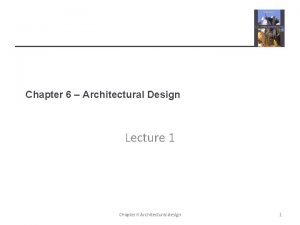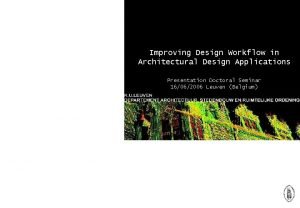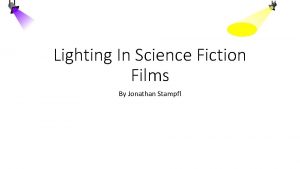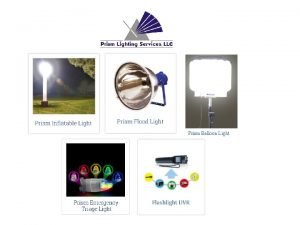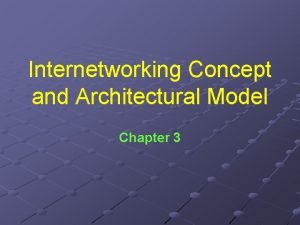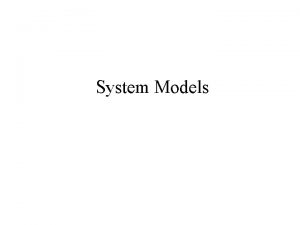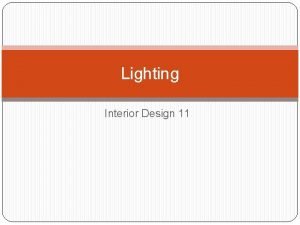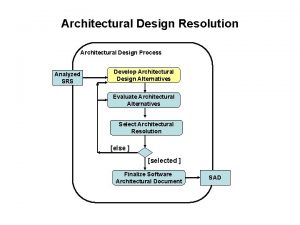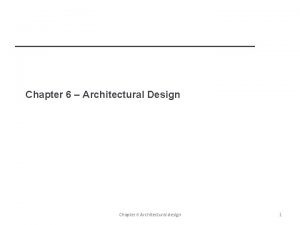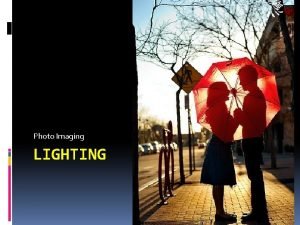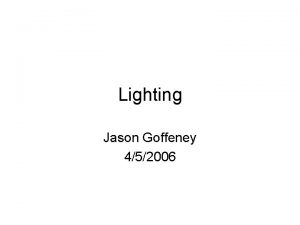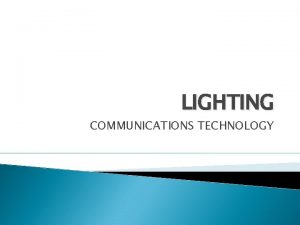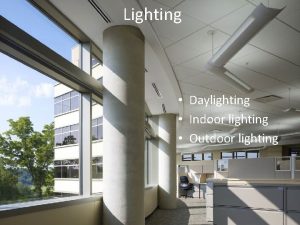Architectural Lighting Design Lighting is a science and















- Slides: 15

Architectural Lighting Design *Lighting is a science and an art. While many of the issues introduced are grounded in science, much of the practical application discussed is grounded in the art of lighting design. *Other lighting designers may empathize on different lighting criteria, on different lighting techniques, on different physiological and/or psychological aspects, and on different cultural aspects. Indeed this what makes lighting more an art and less science. * Other lighting design branches include automotive, television/studio, theatre, exhibit/display, and concert.

* Lighting design intended for permanent architectural applications are: commercial (offices), institutional (healthcare, educational, and libraries, etc. ), hospitality (restaurants, clubs, lounges, and hotels, etc. ), governmental (government centers, and courthouses, etc. ), research (laboratories), and industrial. Residential and retail applications are also considered a part of architectural lighting design. However the latter two applications rely heavily on theoretical techniques.

Definitions • Illuminance: The quantity of light falling on a given surface. Although important, is much too often the only criterion used to design a lighting solution. This is a poor practice. US Customary: footcandles or fc. SI: lux or lx, 10. 76 lx = 1 fc • Power Budget: A code limit on the amount of total watts used for lighting a room or building. US Customary: watts per square foot or W/sf or W/. SI: W/m. Exactly 10. 76 W/m = 1 W/

• Efficacy: The effectiveness of a lamp in producing light (lumens) relative to the power (watts) required to operate the lamp. Expressed as lumens per watt (LPW). • Lumens: A measure of the amount of light emitted by a light source (lamp, sky, sun) or falling onto a surface regardless of directionality. • Lamp: The device producing the visible energy (light). Light bulb is the more colloquial reference.

• Light: Energy or electromagnetic waves operating at a frequency that stimulates photoreceptors in the eye. We respond to light as an “aftereffect”. We see what happens after electromagnetic waves react to or interact with surfaces, objects, and materials. This reflected and/or transmitted light comprises our visual scene. • Lighting has direct and indirect effects on health. For example glare can result in poor ergonomics. Visibility of tasks and therefore accuracy and/or volume of work can be hampered with poor lighting. The lighting design must address these issues and other physiological and psychological issues. Lighting involves space, volume, form, texture, color, image, and people-most of all, people. Lighting is both a physiological and psychological inducer.

• Physiological: Pertaining to the human body’s physical response. Lighting initiates vision through muscular, chemical, and neurological actions. • Psychological: it’s related to human mind’s emotional or subjective response. The brain’s reaction to psychological actions brought on by light. Light and color are believed to influence people’s psychological reactions and influence their preferences for various architectural and/or landscape settings. • Luminaire: The entire assembly of hardware components, including lamp(s), ballast(s), transformer(s), driver(s), lens(es), reflector(s), socket(s), wiring and wiring connections, housing, etc. , that result in a complete, operational lighting assembly.

The Problem • Lighting affects how people feel, react, and function in various settings. It’s a biology or physiology problem as well as a psychology problem. Designers should know, understand able to answer the followings: 1 - How well are people expected to function? 2 - How comfortable are people expected to be while they function? 3 - What is/are the function(s)? 4 - How can lighting best help people by influencing their emotional or subjective reactions in a positive way. 5 -Who are these people, and how do they feel, react, and function in their present lighting situation(s).

Eye Response and Light Designers • The eye responds to differences in specific reflected and transmitted electromagnetic energy (light)-the eye sees chromatic and luminance contrasts. Daylight, moonlight, flame, and electric light characteristics interact with a given setting (architectural, landscape, architectural , or native natural), creating reflections and transmissions of various wavelengths of visible energy for people to behold. • Light designers can manipulate these reflections and transmissions to advantage-that is the charge of the lighting design team.

• Because we see light reflecting from or transmitting through materials, the surface characteristics of these materials are critically important to the color and amount of reflected or transmitted light. A good interior design plan can be ruined by bad lighting and a good lighting design plan can be ruined by bad interior design. • Chromatic Contrast: color contrast or color difference between two or more colors. • Luminance Contrast: Measured brightness difference between two or more elements or details in the viewed scene as perceived by a typical, healthy eye.

Electromagnetic Energy • Electromagnetic energy or radiation is emitted when atomic particles vibrate. The frequency of the vibration determines the kind of radiation emitted. High-frequency vibrations result in very short wavelength radiation, such as cosmic rays, gamma rays, and X-rays. Low-frequency vibrations result in long wavelength radiation, such as microwaves, radio waves, and sound waves. Moderatefrequency vibrations result in ultraviolet radiation, light, and infrared radiation. All of these varying wavelengths of radiation make up the electromagnetic spectrum. The metric for wavelengths is meters. Wavelengths of visible radiation are measured in billionths of a meter-10 meters or nanometers (nm). The shortest wavelengths of the visible energy are about 380 nm (deep violet). The longest are about 770 nm (rich red).

Color • Color vision takes place under relatively high brightness conditions. Such vision is known as photopic. Photopic vision is the scientific term for human color vision under normal lighting conditions during the day, when the activity of the cones in the retina enables the eye to perceive color. Retina a light-sensitive membrane in the back of the eye containing rods and cones that receive an image from the lens and send it to the brain through the optic nerve.

• Color vision lessons with lower brightness settings. Mesopic vision refers to vision that occurs typically at dusk or dawn brightness settings, typified by environments lighted to perhaps 0. 2 to 2 fc (2. 2 to 22 lux). Here, both rods and cones are operating, but the detailed vision the cones offer is diminished by relatively low brightnesses. A rod is a cell of a rod-shaped receptor in the retina of the eye that is sensitive to dim light but not color.

• A cone is a cell of a cone-shaped cell sensitive to light and color in the retina of the eye of a human being or any other vertebrate animal. There are three different types of cone cells, responding to blue, green, or red light. • Scotpic vision takes place under very low brightness settings, typified by environments lighted to less than 0. 2 fc (2. 2 lux-full moon light might offer 0. 5 lux). In such settings, blue-rich electric light sources offers significant visual acuity enhancement to eyesight over more yellow sources. For night lighting of pedestrian paths and around residential areas, this is an important consideration.

• Studies show that using blue-rich sources to have an effect similar to that of doubling or nearly tripling light intensities using more yellow sources-a significant finding for safety and security and for conservation of resources.

Conventions
 Architectural design in software engineering
Architectural design in software engineering Architectural design
Architectural design Architectural design in huddersfield
Architectural design in huddersfield Architecture design objectives
Architecture design objectives Sequence diagram of airline reservation system
Sequence diagram of airline reservation system Architectural design workflow
Architectural design workflow What's your favorite lesson
What's your favorite lesson Science fiction lighting
Science fiction lighting Prism lighting services
Prism lighting services Software architecture styles
Software architecture styles Explain iot conceptual framework.
Explain iot conceptual framework. Architectural styles and patterns
Architectural styles and patterns Internetworking architecture model
Internetworking architecture model Architectural and fundamental models of distributed system
Architectural and fundamental models of distributed system C&c pattern
C&c pattern Airfield lighting design
Airfield lighting design

